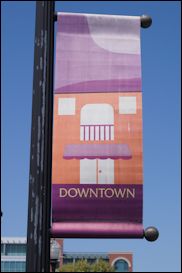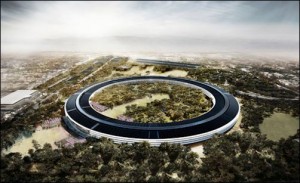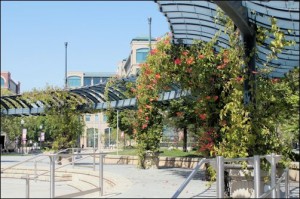Silicon Valley appears to be moving in fits and starts toward more rational land use, creating denser, more mixed-use, better-connected communities appropriate to a region with extraordinarily high land values. As a casual visitor to the region, I don’t pretend to speak with any authority on the trend but I can provide a couple of case studies on how change is happening. The good news for businesses and residents of Silicon Valley is that change is occurring and that the new is better than the old. The bad news is that change isn’t coming fast enough, and the new stuff being built probably could work better.
Projects like the planned 2.8 million-square-foot Apple headquarters complex, one of the final legacies of Steve Jobs, tend to grab the lion’s share of attention. The proposed headquarters, snarkly dubbed the “mothership” for its futuristic design, will be an architectural masterpiece. Apple says the facility will produce as much energy as it consumes and its floor plan will foster creative collaboration. But the complex will be a self-contained campus. While it may encourage collaboration internally, its isolation will not promote interaction with entities outside the corporation. And while the facility itself may be carbon neutral, plans include a vast underground parking lot to accommodate thousands of employees who will be commuting (and burning gasoline) by car.
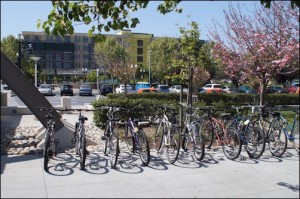
Yes, the Caltrain station provides bike racks — and people are using them. But look carefully at this picture. Beyond the bikes, the valuable land adjacent to the train station is consumed by surface parking lot.
It’s not as if Silicon Valley lacks mass transit. As one would expect of a California locale, the region has made significant investments in rail and bus. A Caltrain track runs from San Francisco to San Jose with several stops along the way. The Santa Clara Valley Transportation Authority runs bus lines throughout. There even appears to be some mixed-use clustering occurring around the transit stations. If the region is to address its long-term challenge of providing more affordable housing and reducing traffic congestion, it will need fewer Apple motherships and more of the uncelebrated development like that which is occurring around the Sunnyvale Caltrain station.
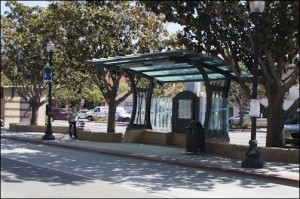
The Caltrain stop is served by an attractive bus station. Too bad nobody was using it when I happened by.
However, local planners and developers in the region also will have to work on their execution. Last week I had spent some time touring the district around the Sunnyvale station. Local planners have done some things right. But my quick and superficial impression is that the district will fall short of potential.
Planners appear to be checking off the smart growth list — light rail. Check. Covered bus stops. Check. Mixed-use buildings, grid streets, bicycle racks, parks, underground parking… Check, check, check.
But the key players appeared to have paid less attention to how all the pieces fit together. The biggest problem is that the train station is surrounded by parking lots and an empty park-like space. The mixed-use, multi-story buildings are all pushed back from the station. Given the reluctance of people to walk more than a quarter mile to transit (roughly 1,500 feet), the most valuable space is located right next to the station. That’s where the greatest density should be. But in Sunnyvale that’s where the lowest-value land uses are located.
The streets and public spaces of this transit-oriented district were empty. The problem wasn’t just the time of day — late morning and lunch-time on a Wednesday. One street was really hopping: South Murphy Avenue. The design was classic New Urbanism with wide sidewalks, on-street parking, narrow lanes, street furniture, ornamental trees and sidewalk dining. The place was packed. I don’t know how people got there, whether they walked or they drove, but the restaurants were jammed.
Other than South Murphy, there was little street life. There wasn’t even much automobile traffic. Perhaps it’s premature to draw conclusions. After all, construction was underway for some major multi-story apartment buildings. At some point, those residences will be filled and they may contribute to pedestrian traffic. On the other hand, residents may end up just commuting to sprawling corporate campuses like those of Apple and Google. Without major employers in the mixed-use business district, the “mixed” use isn’t likely to have much impact.
One other observation: The re-development that is occurring may be way too limited. As one of the greatest centers of wealth creation in the world, and one that happens to be hemmed in by water and mountains, Silicon Valley has sky-high real estate prices. Demand could easily support more density than the two-, three- and four-story buildings around Sunnyvale’s train station. The region could easily support San Francisco-scale density. NIMBYs are terrified, of course, that greater density will bring greater congestion, and they’re probably right. But the region is already spending hundreds of millions of dollars yearly on mass transit which seems scandalously under-utilized. (Fares in Fiscal 2013 accounted for only 10% of so of transportation authority revenue.) It is the height of folly to spend so much money on mass transit without zoning appropriately around train stations and bus lines.
Sunnyvale and the valley’s other municipalities should be evolving to much higher-density urban forms. The region’s inability to do so will continue to prop up insanely high real estate prices, making it unaffordable to all but the top echelon of technology talent to move there. California arguably could capture a much larger share of the wealth created in the valley but restrictive policies will push lower- and middle-income occupations to other states.

